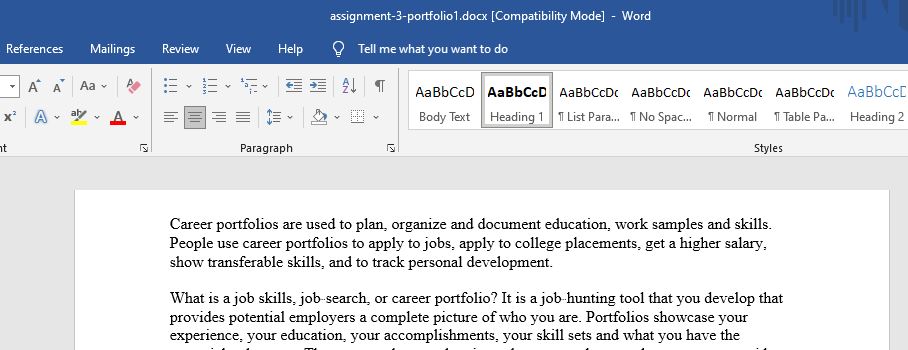Discuss professional practice portfolio
Career portfolios are used to plan, organize and document education, work samples and skills. People use career portfolios to apply to jobs, apply to college placements, get a higher salary, show transferable skills, and to track personal development.
What is a job skills, job-‐search, or career portfolio? It is a job-‐hunting tool that you develop that provides potential employers a complete picture of who you are. Portfolios showcase your experience, your education, your accomplishments, your skill sets and what you have the potential to become. They are much more than just what a cover letter and resume can provide. You can use your career portfolio in job placement interviews and future career interviews to showcase a point, to illustrate the depth of your skills and experience, or to use as a tool to get a second interview.
Your biggest time commitments will be the initial development of your portfolio, but once you’ve done this, keeping it current and up-‐to-‐date should be fairly easy. Your two biggest decisions in developing your portfolio are determining the format of the portfolio and the organization of the portfolio.
Your portfolio is a dynamic document, to which you will be adding materials and refining as you continue in the SSW & MHAW program(s), and throughout your career. As this course focuses on developing knowledge of relevant skills of professionalism, these should be highlighted in your submission for this course; as well it is recommended you also include relevant skills and knowledge from all of your other courses you have taken thus far.
Suggested inclusions could include: examples of your professional SSW / MAHW skills; demonstration of your own personal unique skills, talents, and experiences that you will bring to your practice as an SSW / MAHW; and areas of personal interest and development that would be relevant to an agency, such as volunteer or fundraising experience. You should also include a table of contents and use tabs or dividers to separate the various parts of the portfolio. You want to easily access the items you would be referring to during an interview.
Once the development is complete, you then have to gather, write, copy, and assemble the material that goes in the portfolio. This process will not only result in a professional portfolio, but should help you be better prepared for your job search.
The key to remember as you contemplate these items is that you want to give reasons for the employer to hire you ~ you want to showcase your education and work experience by showing examples and evidence of your work, skills, and accomplishments. Your portfolio is an opportunity to give yourself an edge.
Building your Portfolio:
- Professional Philosophy/Mission Statement: A short description of the guiding principles that drive you and give you
Cover Letter and Resume: Make the revisions to your cover letter and resume from the feedback received in assignment #2, and place both of these in your portfolio close to the front
- Skills, Abilities and Marketable Qualities: A detailed examination of your skills and experience. This section should include the name of the skill area; the performance or behaviour, knowledge, or personal traits that contribute to your success in that skill area; your background and specific experiences that demonstrate your application of the
- List of Accomplishments: A detailed listing that highlights the major accomplishments in your education and/or career to date. Accomplishments are one of the most important elements of any good job-‐sear Make sure to add your Grade Audit form in here too.
- Samples of Your Work: A sampling of your best work, including reports, papers, studies, brochures, projects, presentations,
- Transcripts, Degrees, Licenses, and Certifications: Proof and a description of relevant courses, degrees, licenses, and certifications you’ve completed.
- Volunteering/Community Service: Volunteer Service Verification Form filled out with your hours or your plan to complete hours. On a separate page, provide a description of any community service activities, or volunteer work you have completed, especially as it relates to your
Answer preview:
Words: 372

